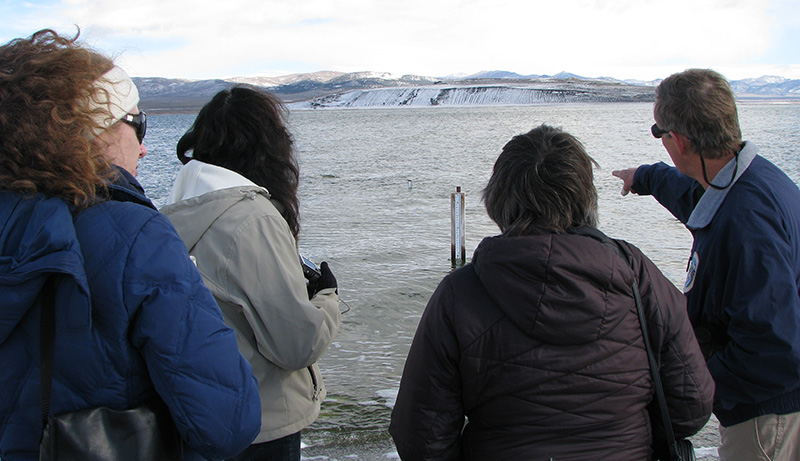
Yesterday marked the first day of the 2014 runoff year, and it is also time for adding up the total runoff from the 2013 runoff year.

A runoff year runs from April 1 to March 31, and enables tracking of stream runoff from the time of peak snowpack from one year to the next. Mono Basin runoff was about 54.5% of average between April 1, 2013 and March 31, 2014. This is 17.4% less runoff than the 66% of average runoff forecasted one year ago, thanks to the very dry spring, fall, and winter (last summer, precipitation was above-average thanks to thunderstorms). It was the second-farthest-off runoff prediction since the California State Water Resources Control Board’s Decision 1631 in 1994, after 18.6% too much runoff was predicted in 2008.
During the 2013 runoff year, Cain Ranch precipitation was 56% of average, and Ellery Lake precipitation was 45% of average. At Ellery Lake the precipitation recorded during the 2013 runoff year was the second lowest (after 1947) since records began in 1925.
April 1st not only marks the 2014 runoff year’s beginning, but the halfway point through the 2014 water year (October 1 to September 30). It is the end of the wet half, when 80% of our precipitation typically occurs. Precipitation in Lee Vining has been 53% of average so far this water year. This convergence of precipitation numbers in the low-50s percent-wise for time periods centering on this past winter is a good indication that our snowpack and our 2014 runoff will also likely be around 50% of average. Later this week the April 1st snow survey results should be available, and sometime late next week we should get a runoff forecast from the Los Angeles Department of Water & Power (DWP). There really is no question that it will be another dry year like last year, but to find out how dry, we have to wait another couple of weeks.
Also in mid-April, DWP will issue a lake level forecast for Mono Lake for the 2014 runoff year. Surprisingly, during the month of March, Mono Lake didn’t rise–the first March without a rise in a dozen years, despite above-average precipitation at Cain Ranch (a weather station representative of precipitation on Mono Lake). It ended the month at 6380.7 feet above sea level, 1.5 feet lower than it was a year ago. Unless next winter is quite wet, it is likely Mono Lake will be below 6380 feet a year from now, triggering at that time a reduction in DWP exports from the Mono Basin from 16,000 acre-feet per year to 4,500 acre-feet per year.
2012 runoff was 52% of average. 2013 runoff was 55% of average. 2014 runoff is likely to be in a similar range—perhaps 50% of average. There aren’t three years in a row this dry in the Mono Basin records that go back to 1935. The driest consecutive three years in the period of record was 1959–61, when runoff was 58.9%, 56.5%, and 58.7%—each wetter than last year, which was the wettest of the three-year period we are currently in. This puts the cumulative consecutive dryness in the Mono Basin this coming year in uncharted territory, and means our hydrologic models based on previous years will be stretched beyond their limits. The 1987-1992 period was drier but over a longer non-consecutive period. The driest two year period was 1976–77, with 46.1% and 44.4% of average runoff, respectively. The 2014 runoff year will likely seem drier than 1977 for things that respond to cumulative dryness, like groundwater levels, spring flow, and the growth of certain plants (but not as dry as 1987-1992). However, something like runoff, which is more influenced by a single year’s snowpack, will respond to more wet conditions than 1977. The result is going to be a new data point, and this new information will be very useful in our understanding of the water cycle in the Mono Basin. But it sure is unfortunate for Mono Lake, which will drop another foot or more.

[…] 2012-2014 on track to be driest 3 consecutive years on record in the Mono Basin: “Yesterday marked the first day of the 2014 runoff year, and it is also time for adding up the total runoff from the 2013 runoff year. A runoff year runs from April 1 to March 31, and enables tracking of stream runoff from the time of peak snowpack from one year to the next. Mono Basin runoff was about 54.5% of average between April 1, 2013 and March 31, 2014. This is 17.4% less runoff than the 66% of average runoff forecasted one year ago, thanks to the very dry spring, fall, and winter (last summer, precipitation was above-average thanks to thunderstorms). It was the second-farthest-off runoff prediction since the California State Water Resources Control Board’s Decision 1631 in 1994, after 18.6% too much runoff was predicted in 2008. … “ Read more from the Mono-Logue here: 2012-2014 on track to be driest 3 consecutive years on record […]